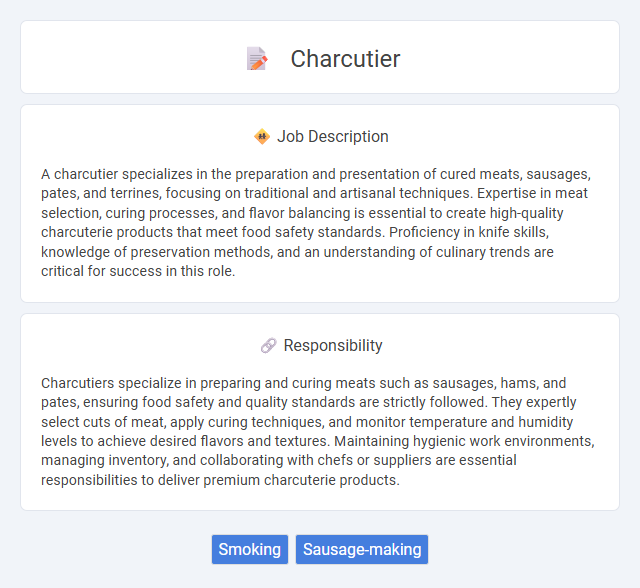
A charcutier specializes in the preparation and presentation of cured meats, sausages, pates, and terrines, focusing on traditional and artisanal techniques. Expertise in meat selection, curing processes, and flavor balancing is essential to create high-quality charcuterie products that meet food safety standards. Proficiency in knife skills, knowledge of preservation methods, and an understanding of culinary trends are critical for success in this role.
Individuals who have a strong interest in food preparation and enjoy working with meats may find the charcutier profession suitable. Those comfortable standing for long hours, handling sharp tools, and maintaining strict hygiene standards will likely thrive. People with attention to detail and a preference for hands-on, physically engaging tasks probably have a higher chance of success in this role.
Qualification
A Charcutier must possess comprehensive knowledge of meat curing, smoking, and seasoning techniques, along with food safety and hygiene standards. Professional qualifications often include certifications in butchery or culinary arts, complemented by hands-on apprenticeships in charcuterie. Expertise in selecting quality meats and mastering preservation methods is essential for producing safe and flavorful charcuterie products.
Responsibility
Charcutiers specialize in preparing and curing meats such as sausages, hams, and pates, ensuring food safety and quality standards are strictly followed. They expertly select cuts of meat, apply curing techniques, and monitor temperature and humidity levels to achieve desired flavors and textures. Maintaining hygienic work environments, managing inventory, and collaborating with chefs or suppliers are essential responsibilities to deliver premium charcuterie products.
Benefit
Working as a charcutier likely offers the benefit of developing specialized culinary skills in meat curing and preparation, which can enhance career prospects in gourmet food industries. The role probably provides opportunities to work in artisanal or high-end food environments, potentially increasing job satisfaction and professional recognition. Furthermore, charcutiers may benefit from a growing market demand for authentic, handcrafted charcuterie products, supporting job stability and income growth.
Challenge
The role of a charcutier likely involves overcoming challenges related to maintaining consistent quality while managing perishable ingredients. Precision and attention to hygiene probably play a critical part in ensuring products meet safety standards. Balancing traditional techniques with modern food trends might also present ongoing difficulties in this profession.
Career Advancement
Career advancement for a charcutier often involves progressing from entry-level roles to master charcutier positions, specializing in artisanal meat curing techniques. Skilled professionals can open their own charcuterie shops or move into food quality control and product development within the meat processing industry. Continuous training in meat science and food safety certifications enhances job prospects and leadership opportunities.
Key Terms
Smoking
A Charcutier specializes in the art of smoking meats, enhancing flavor and preserving the product through controlled exposure to smoke from burning wood or sawdust. Mastery of smoking techniques ensures optimal texture and taste, crucial for premium charcuterie products such as smoked sausages, ham, and bacon. Knowledge of temperature control, smoke types, and curing times is essential for producing high-quality smoked meats that meet food safety standards.
Sausage-making
Charcutiers specialize in sausage-making, expertly blending and seasoning meats to create a variety of traditional and artisanal sausages. Their knowledge of curing techniques, meat fermentation, and grinding ensures optimal flavor and texture in products such as salami, chorizo, and bratwurst. Precision in ingredient ratios and strict hygiene standards are critical to maintaining safety and quality in all stages of sausage production.
 kuljobs.com
kuljobs.com